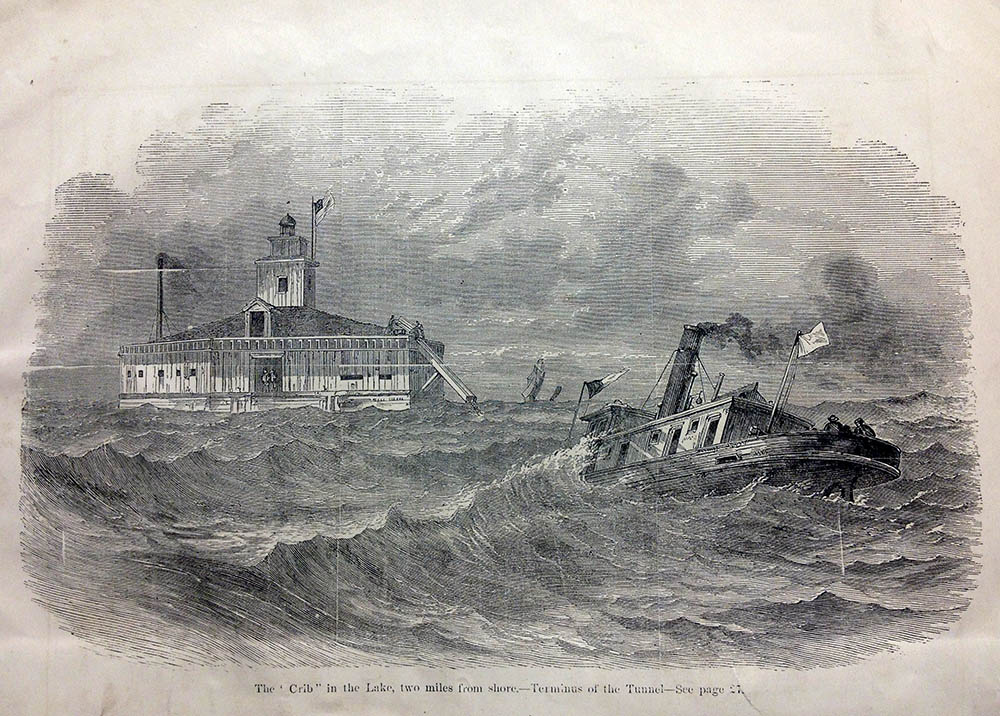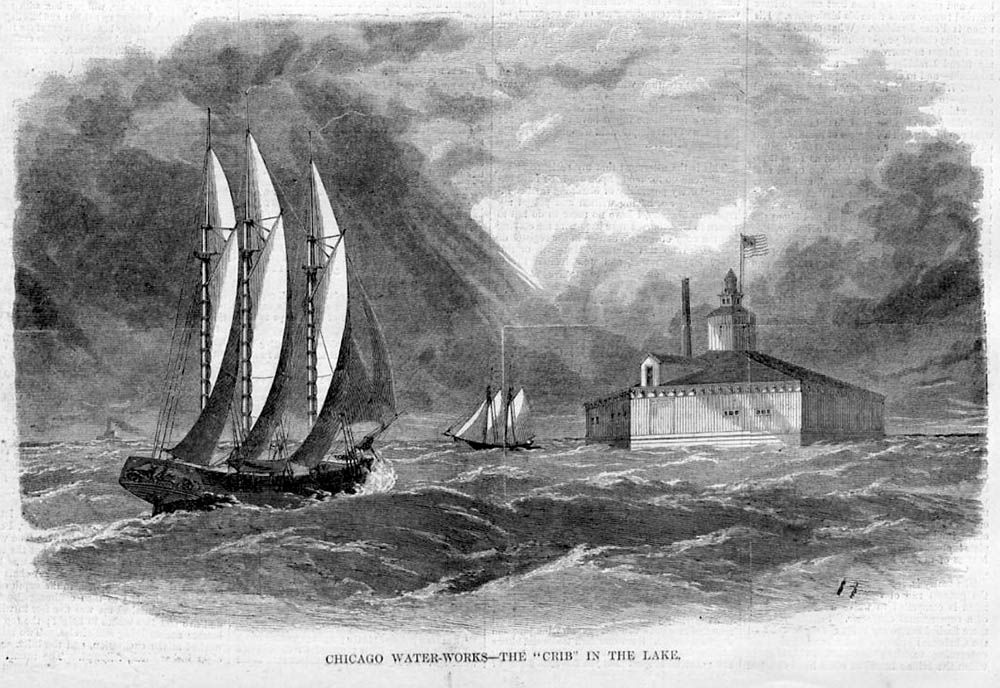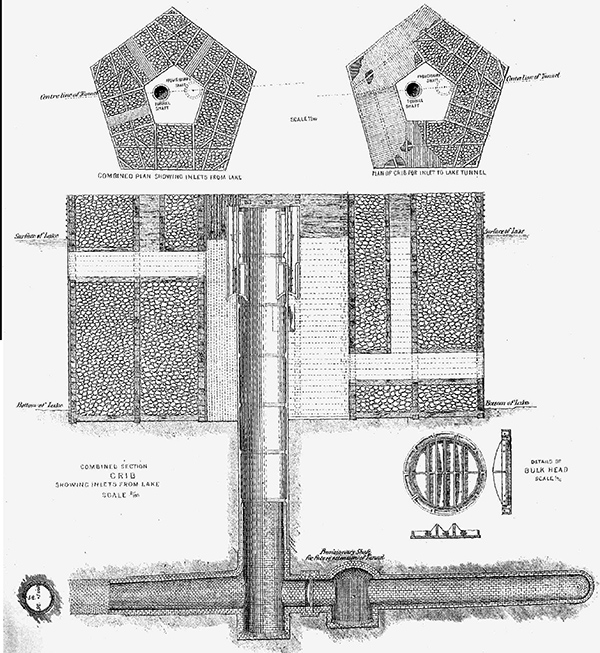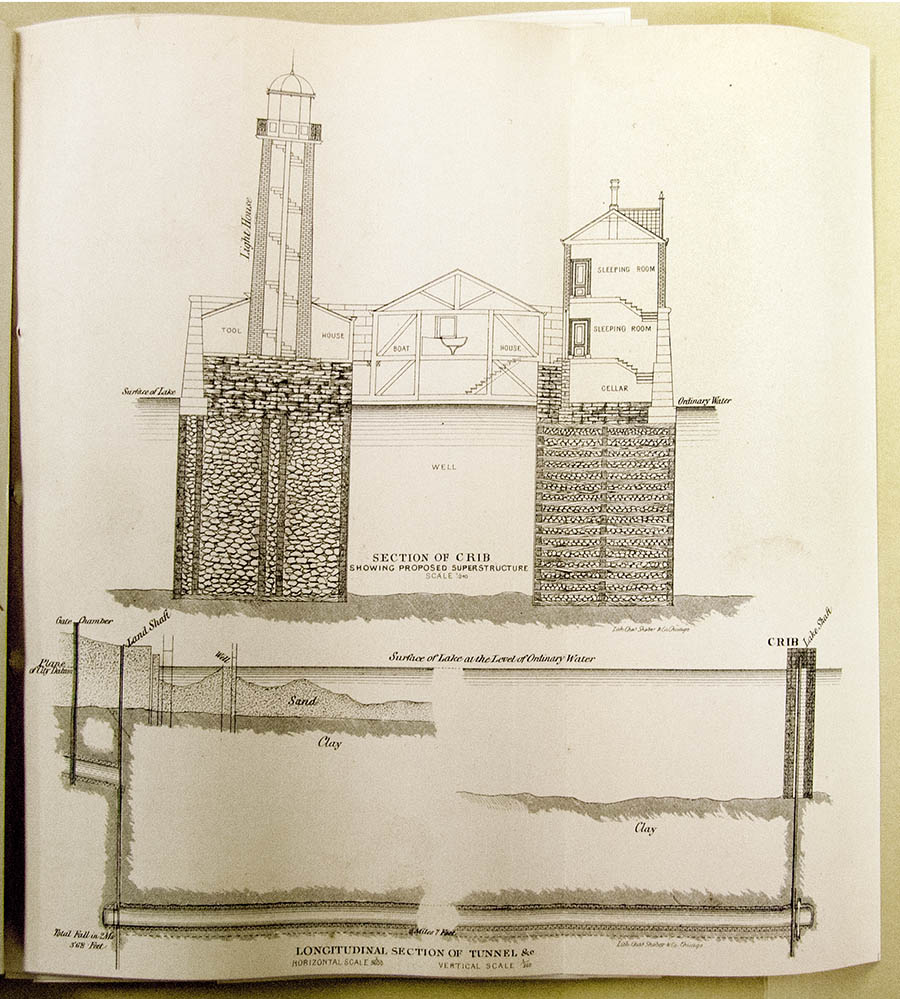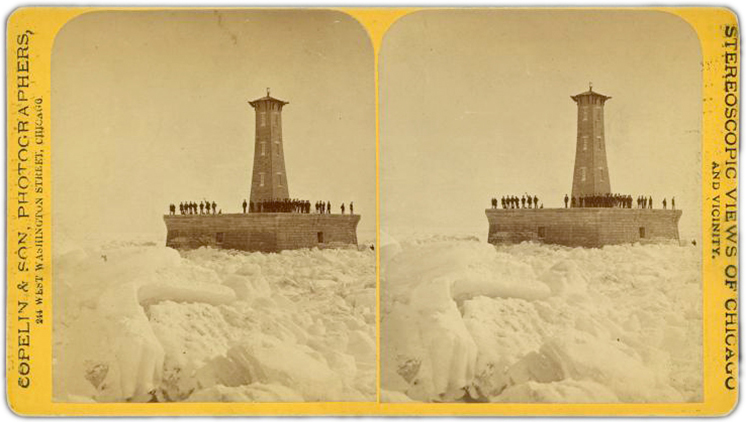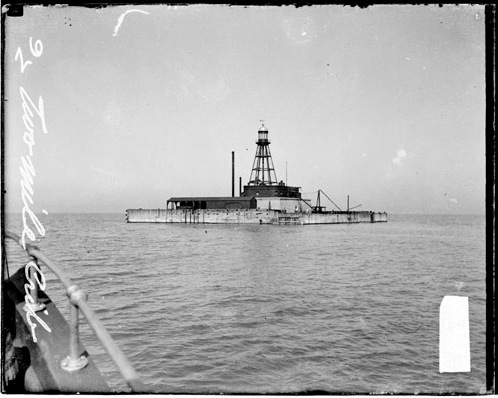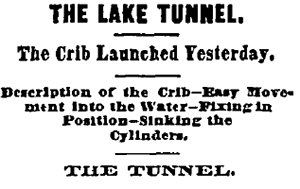The launch of the giant crib for the east end of the great lake tunnel was safely accomplished yesterday morning, after innumerable delays, extending through a period of several weeks. It was done so neatly and so easily as to astonish every one among the thousands who watched its passage from its native element into the water. It will be observed that we invert the usual phrase, according to which a vessel is native in the element to which it enumerates – a phrase, by the way quite foreign to the subject.
It is now some weeks since the time first fixed upon for the launch; first bad weather, then an accident, then bad weather, then more bad weather, then a breaking up of the siloing ways by collision with a vessel, and then again, another touch of bad weather, caused collectively a long delay. Very many of those who read the announcements that the launch would positively be made yesterday, disbelieved it, as the morning broke ominously; but for this fact the crowd would have been much greater. Yet there was no lack of attendance, and spite of the threatened wind and rain, the murky clouds, and the angry waters of the lake the directing contractor – Mr. Gowan, decided to venture, and was rewarded in one of the most complete successes on record.
The crib lay on the north Pier, a few rods west of the lighthouse, where it has been constructed and where no doubt a majority of our citizens have seen it, either closely or at a distance. The latter was no difficult task as its huge unwieldy proportions made it a very conspicuous object. The monster resembles nothing at all, either in the heavens above or the waters beneath, and the only conceivable parallel would be the appearance of Gulliver’s Brobdignagian box dropped down among the Lilliputians – the chances are that its advent there would have forever silenced their squabbles by breaking their egg at both ends, crushing them to atoms, and driving their island out of sight. It is certainly a monster egg for any ordinary mortal to break, and whichever end he might essay he would find it a big one; let us hope that the chicken proposed to be hatched will prove it to be worth the trouble.
The crib is forty feet and a half high, and built in pentagonal form, in a circumscribing circle of ninety-eight and half feet diameter. We have previously described its construction minutely, and anything more than a brief recapitulation is therefore unnecessary. It is built of logs one foot square, and consists of three walls, at a distance of eleven feet from each other, leaving a central pentagonal space having an unscribed circle of twenty-five feet, within which will be fixed the iron cylinder, nine feet in diameter, to run from the water line to the tunnel, sixty-four feet below the surface and thirty one feet below the bed of the lake at that point. The crib is thoroughly braced in every direction, so that it might be tumbled over and over without injury. It contains 750,000 feet of lumber, board measure, and 150 tons of iron bolts’ it weighs about 1,800 tons. The outside is thoroughly caulked, equal to a first class vessel with three threads in each seam, the first and last being what is called “horsed.” Over all these there is a layer of lagging, which will keep the caulking in place, and protect the crib proper from the action of the waves. Above is a diagram of the crib, (horizontal section) with the cylinder inside.
The crib was placed on seven ways, each one hundred and forty feet long, dipping down into the water on an incline of one inch to the foot. It was let down on there by two hundred and fifty screws, similar to those used in house moving and raising. At an early hour yesterday all the screws were got into position, and the ways greased. Nothing remained but the presence of the invited guests, to allow of the great slide being taken.
The scene was decidedly a gay one. Seven tugs steamed about the month of the harbor, filled with eager spectators, small boats, innumerable played on the surging water, the decks and rigging of numerous sail vessels were covered and filled, and the shore for a long distance in each direction was comfortably crowded. A vast amount of speculation was indulged in while the preparations were in progress, as to the success of what everybody felt to be an experiment, and the tugs moved about very uneasily, in the alternating desire of 150 passengers to secure a good view, and to be in a safe place. Many there were who asserted that the monster never would be moved, not a few prophesied that it would topple over, and one gentleman naively suggested that if no one else could do it, Long John would manage the job; he had shown himself as adept in former years in pulling cribs off the Sands.
Well, the time came at last, The a was wielded which revered the rope, and the leviathan guided down the ways, so beautifully, so gracefully, so majestically, that words fail to describe it. The one hundred and forty feet were traversed in about one minute, without jerk or break, needing neither push nor retard, and went into the water so quietly that a boat containing two boys, who got in the way, as boys always will, were within a couple of yards of the monster’s front, was not even shaken, much less upset. The wave produced was like the ocean’s gentlest swell – such a wave as probably was never before seen on Lake Michigan. Everybody was delighted, and the most enthusiastic cheers rent the air; the tugs joined in with their iron threats and not very agreeable voices, and for awhile the noise resembled that of Babel, while the crib might easily have been mistaken for its tower.
The tug, “A.B. Ward,” having on board Governor Oglesby, Col. Bowen and Col. Snyder of the Governor’s staff, U.P. Harris, Dr. Brainerd, several members of the Common Council, and the usual sprinkling of representatives of the Press, was the first to make the circuit of the crib, and soon with the tug “Continental” took a “line” and commenced to tow out the crib to its final resting place. This occupied about an hour and a half, the journey being rendered rather disagreeable by the drizzling rain which set in, and a decent swell, which, however, did not materially retard progress. Before noon the crib was in position, two miles from shore, in the middle of the anchors put down several days before, and whose places were marked by buoys, the lines cast off, and the tugs preparing to return to the city.
One could not but observe the purity of the water at this point in the lake; notwithstanding the fact that off shore it was turbid in consequence of the bad weather, it was there translucent, perfectly clear and pure. The position is undoubtedly one of the best that could have been selected. Water taken from that point has never shown more than eight grains of solid matter to the gallon: it is far away enough from shore to be unaffected by storms, and the northwesterly current in the lake carries away all the filth emptied into Lake Michigan, round the bend, and down again on the eastern shore, if nothing happens to bar the finishing of the tunnel, or to break it up when finished, Chicago will have secured an inexhaustible supply of the purest water on the continent or in the world.
The only accident occurring to the party was a small one to the tug S.V.R Watson, which got her screw entangled in one of the buoys, and was unable to get clear till a boat was procured form shore; her passengers were transferred to the “Ward.” It is worthy of remark in this connection that no accident involving personal injury has occurred since the commencement of the work, nearly two years ago.
The crib, on arriving at her destination, was allowed to fill with water, by opening the sluices made for that purpose, and when the party left her she was slowly settling down toward the bed of the lake. She drew only six and a half feet of water. The squeons filling will take her down about nineteen feet. It will take about 600 tons of stone (filled in the bulkheads as marked in the diagram) to sink her to the bottom, which will be filled up as soon as she can be accurately place in the required position, by mooring to the anchors. The crib will hold 4,500 tons of stone when filled, giving an extra weight of 3,900 tons for steadying against the waves. The crib as now built will stand about seven feet above the water line, but when filled in, another five feet will be added. This will give a maximum area of 1,200 feet which can be exposed as one sweep to the action of the waves, reckoning the resistance as perpendicular. In other words, there cannot under any circumstances be less than three and a half tons of weight to each square foot exposed to action of the waves. The crib is now kept in place by five of Mitchell’s marine screws, each one having a screw of thirty inches across, thirty two inches in length, a hold on the clay of ten feet, and weight of 600 pounds.
The crib is moored at a distance of exactly two miles from shore in a direction perpendicular to the shore line, about two points to the north of due east, from the shore end of the tunnel at the Water Works. It is expected that the excavation will be commenced at the lake end about the middle of September, when the work will be presented from both ends and be probably finished in twelve months from the present date. Exactly one-third of the whole length is already finished. The preliminary to the lake end excavation, is now the fixing of the iron cylinder down the crib to pierce the clay to the total depth of sixty-four feet form the surface of the water. The cylinder, nine feet in diameter, and one and a half to two inches thick, will be put down in sections of nine or ten feet long, the lower one having a chisel edge to cut through the soil, and the joints being made perfectly water tight, the flanges being broad, turned true, and grooved out to take in a ridge of cement. The work of putting down the first four or five will be but little; the bed of the lake being reached, the top will be covered with an airtight plate, in which will be placed an air pump. The air and water being exhausted the superincumbent pressure of the atmosphere will be more than force sufficient to force the iron column down through the earth without digging, and with this advantage, that the flanges at the joints being internal, the outer surface will be perfectly smooth, and the lower section being made slightly conical the lower end the smallest, the cylinder will fit the soil like a wedge and allow not a drop of water to reach the base from the outside, even under the great pressure to which it is there subjected. Forced down to the required depth, the air will be let in, the top taken off, another section put on, the pneumatic process re-instituted, and the sinking proceeded with as before. A covered platform, or house, built over the whole will enable the workmen to prosecute the work uninterrupted by rain or wind, and in the same manner the excavation when that is commenced, the earth brought up bing carried away by scows whose return cargoes will be bricks for the lining of the tunnel. The bore completed, the top of the cylinder will be covered with a grating to keep out floating logs, fish, &c. a sluice made in the side of the crib will be opened to let in the water, and a lighthouse will be built over all, serving the double purpose of guarding the crib from injury by vessels, and of showing the way to the harbor of Chicago.
It was originally intended to put down two or three intermediate cribs along the line of the tunnel, but it was found to be unnecessary. One at the farther end is all that is needed the tunnel is five feet two inches in perpendicular diameter, and five feet horizontal diameter, in the clear. The lining is of brick fully cemented. The bore slopes towards the shore at a rate of two feet per mile, which will enable the workmen to empty the tunnel should repairs be necessary. Many doubts have been expressed that the immense pressure of water will force out the brickwork and cause a grand collapse. There is little need to hear this; the bricks are set into the solid clay, which is as hard as the rock itself, and can never give way while the water above presses down upon it, with a pressure exactly equal to that exerted in the tunnel.
The contractors are Messrs. Dull & Gowan, of Harrisburg, Pa. the contract price is $315, 109; the amount paid will vary somewhat from these figures, how much we cannot say.
The tunnel itself will be, when completed, one of the wonders of the world, worthy of taking its place as the eight. We believe that such a work has never before been undertaken. Aqueducts have ere now been carried across valleys, and canals have been driven through mountains, but not on the airtight principle. It remains for Chicago, herself a wonder of the world, to show to its civilized portion how a watertight canal can be formed under the bed of a mighty lake, running out to a distance of two miles towards the rising sun. it is an advance step in the march of progress, whose twin and complement is the great observatory – the one is an exploration of the earth never before attempted, the other will enable us to penetrate more deeply into the infinities of space than has ever yet been achieved by the most scientific peoples of the world. Chicago is going ahead, and her every effort is a gigantic stride towards perfection. |
Chicago Daily Tribune, July 27, 1865
THE TUNNEL CRIB
The tunnel crib has not moved from its moorings anymore than teh slight occasional slackening and straining of the cables, a foor or more, as the wind changed, was expected to occasion, and not the slightest fears are entertained of its doing so. It is still, however, some six feet from the bottom of the lake, and as the stone required to bring it down is not procurable as readily as it is desirable, it is intended to use wrecking pumps, and fill in with water the eight or nine feet of compartments above the level of the lake. This is but a temporary resort, but will, it is believed, be effectual in putting the crib down firmly upon the bed of the lake.
The Chicago Journal, July 26, 1865
We chronicle today an epoch in the history of Chicago, and the herculean efforts put forth by her authorities to obtain a supply of pure water for the use of her two hundred thousand inhabitants. Our readers are familiar with the history of the great lake tunnel, now in process of construction, every important feature and movement of which have been from time to time chronicled in these columns. The filthy condition of the Chicago River, made so by the numerous slaughtering and rendering establishments along its banks, and to which the entire sewerage system of the city is tributary, contaminated the water of the lake so far out that the old water-pipes, which gathered their supply at less than a mile from the shore, not unfrequently yielded water of very questionable quality. Hence the necessity for procuring water at a greater distance into the lake. A long series of observations resultd in establishing the fact that at two miles from the shore the water is always clear and pure. But how to get a supply from that distance, and in sufficient quantity to meet the demands of a rapidly increasing population, was a problem not easily solved. Science mastered it, and its solution is clear enough to satisfy the most cynical. A monster tunnel, five feet in diameter in the clear, dug under the bottom of the lake, was determined upon, and for upward of a year has been in course of construction. The cost of this immense work – a work that has been described and commented upon by the press of every land – will be over $300,000. The contractors are Messrs. Dull & Gowan, of Pittsburg, Pennsylvania – gentlemen of acknowledged scientific and practical ability, whose energy has been the admiration of all familiar with the difficulties to be surmounted.
When ground was broken for the shaft at the shore end of the tunnel a year ago, the event was considered the most important one in the local history of our city. From that time, day and night, the work has been progressing until it has reached a distance of over three thousand feet.
Today the monster crib was successfully launched, the spectacle being witnessed by thousands of spectators, among whom was Governor Oglesby, and Colonels Snyder and Brown, of his staff. Fair weather and a smooth lake were indispensable requisites to the success of the great work, and for these the contractors have waited long and patiently. A finer day could not have been wished for than was today. It having been announced that the structure would be launched this morning, weather permitting, our citizens took it for granted that the time had arrived, and flocked to the mouth of the harbor by thousands. Nor were they disappointed. At a few minutes past ten o’clock the structure glided into the water as gracefully as a swan, and floated therein, to the admiration of every body. Then cheers arose form the multitude – men huzzaed, ladies waved their handkerchiefs. A dozen steamers and tugs, all of which were freighted with people, simultaneously screamed a long note of welcome from their steam whistles, and thus the second great event in the history of the pure water enterprises of Chicago was celebrated.
The tugs at once took the monster in tow and slowly steamed out toward its intended location, a large number of ladies and gentlemen, and the Gubernatorial party above referred to, accompanying the expedition.
The crib arrived at the buoys at 12 o’clock, and was immediately anchored thereto. These buoys, five in number, are attached to as many one and a half inch cables, anchored to the bottom with five of Mitchell’s marine mooring screws, which are screwed into the firm clay, and are capable of resisting any amount of pressure. These screws are used in the English Channel for mooring the heaviest line of battle ships, and will secure the crib beyond the possibility of danger.
The crib is constructed of over 750,000 feet of lumber, is forty and one-half feet high, is five-sided and measures ninety-eight and a half feet across. Immense beams of hard wood are laid up, tier upon tier, supported and braced by thwarts and huge iron bolts, and cased with heavy three-inch oak plank. It is divided into five water-tight compartments, each of which is provided with valves for letting in the water and sinking it. These compartments will be filled with stone, and when so filled and anchored, the crib will extend but five feet above the water.
In the center of the crib is a large hollow space, into which huge cast iron cylinders will be lowered and forced down into the bed of the lake. The water will be pumped out of these cylinders, and the workmen will then commence excavating under the lake, striking out to meet those engaged at the other end of the tunnel. The work will then progress with great rapidity, and in a few short months Chicago will have an ample supply of as pure and healthy water as can be found in the world.
|
 |
